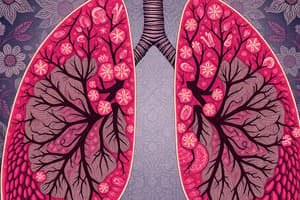Podcast
Questions and Answers
A patient with lung cancer reports persistent bone pain. This symptom most likely indicates which of the following?
A patient with lung cancer reports persistent bone pain. This symptom most likely indicates which of the following?
- The patient has developed a bone fracture due to osteoporosis.
- The cancer has metastasized to the bone. (correct)
- The patient is experiencing muscle strain from physical activity.
- The cancer is responding well to treatment.
All types of cardiomyopathy result in the thickening of the heart muscle.
All types of cardiomyopathy result in the thickening of the heart muscle.
False (B)
Name three common clinical manifestations of lung cancer.
Name three common clinical manifestations of lung cancer.
Persistent cough, shortness of breath, chest pain
For patients undergoing radiation therapy for lung cancer, nursing implementation includes monitoring for skin ______ in the treatment area.
For patients undergoing radiation therapy for lung cancer, nursing implementation includes monitoring for skin ______ in the treatment area.
Match the pharmacological interventions for cardiomyopathy with their primary effect:
Match the pharmacological interventions for cardiomyopathy with their primary effect:
Flashcards
Lung Cancer Metastasis
Lung Cancer Metastasis
Ability of lung cancer to spread to distant sites.
Lung Cancer
Lung Cancer
Uncontrolled growth of abnormal cells in the lungs.
Cardiomyopathy
Cardiomyopathy
A chronic condition of the heart muscle.
Diuretics in Heart Failure
Diuretics in Heart Failure
Signup and view all the flashcards
Types of Cardiomyopathy
Types of Cardiomyopathy
Signup and view all the flashcards
Study Notes
- Lung cancer can metastasize to the bone, spinal column, brain, and lymph nodes.
Overview of Lung Cancer
- Prognosis is generally poor, particularly in advanced stages 3 and 4.
- Bronchogenic carcinoma is categorized into small-cell and non-small cell carcinoma.
- Non-small cell carcinoma includes adenocarcinoma, squamous cell carcinoma, and large-cell carcinoma.
- Lung cancer's pathophysiology involves mutated bronchial epithelial cells.
Risk Factors
- Risk factors include older age, cigarette smoking, exposure to ionizing radiation, inhaled irritants, and radon exposure.
Health Promotion
- Health promotion includes avoiding smoking, limiting occupational exposures, and regular health examinations, especially for high-risk groups like diesel mechanics.
Clinical Manifestations
- Clinical manifestations include persistent cough, hemoptysis, dyspnea, wheezing, clubbing, and recurrent infections like pneumonia.
- Paraneoplastic Syndromes are disorders from tumor secretions affecting various body systems.
- Metastasis is common to the brain and bone.
Diagnostic Tests
- Diagnostic imaging includes CXR, CT, and MRI.
- Additional diagnostic tests are sputum analysis, bronchoscopy, cytological exams, serum labs (CBC, BMP), and pulmonary function tests (PFT).
Surgical Interventions
- Pre/Post-Operative Care involves monitoring vital signs, assessing breath sounds, and managing oxygen therapy and medications.
Pharmacological Interventions
- Pharmacological interventions include chemotherapy, immunotherapy, targeted therapy, bronchodilators, corticosteroids, and analgesics.
Radiation Therapy
- Radiation therapy includes external beam, internal seed, and photodynamic therapy.
- Common side effects include skin irritation, fatigue, and nausea.
Complications of Lung Cancer
- Complications can include superior vena cava syndrome, hypercalcemia, SIADH, pleural effusions, infections, and spinal cord compression, and pulmonary scarring.
Nursing Implementation
- Assessment focuses on respiratory function and pain management.
- Education involves informing about the disease, treatment options, and end-of-life planning.
- Fatigue management encourages rest, supplemental O2, and frequent small meals.
Overview of Cardiomyopathy
- Defined as diseases affecting heart muscle function and can be dilated, hypertrophic, restrictive, or arrhythmogenic.
- Pathophysiology impacts the heart's ability to pump effectively and may be acute or chronic.
Risk Factors
- Risk factors include family history, endocrine disorders, and substance abuse.
Pharmacological Interventions
- Beta Blockers decrease heart workload (e.g., Metoprolol).
- Calcium Channel Blockers reduce heart rate and contractility (e.g., Verapamil).
- ACE Inhibitors/ARBs improve blood flow and lower BP (e.g., Lisinopril).
- Diuretics manage fluid overload (e.g., Furosemide).
Types of Cardiomyopathy
- Dilated cardiomyopathy involves poor cardiac output from enlarged heart chambers and risk factors like alcohol and chemotherapy.
- Hypertrophic cardiomyopathy is characterized by thickened heart muscle and can lead to sudden cardiac death in young athletes.
- Restrictive cardiomyopathy involves stiff heart muscle due to infiltration, such as amyloidosis.
- ARVD (Arrhythmogenic Right Ventricular Dysplasia) is the replacement of heart tissue with fat and is often asymptomatic until sudden death.
Diagnostic Tests
- Diagnostic tests include echocardiogram, ECG, CXR, hemodynamic monitoring, and myocardial biopsy.
Nursing Implementation
- Education includes educating patients/families on symptoms and lifestyle changes.
- Nurses should also monitor fluid volume status and improve cardiac output.
- Assess and manage fatigue, ensuring energy-conserving strategies.
Studying That Suits You
Use AI to generate personalized quizzes and flashcards to suit your learning preferences.




